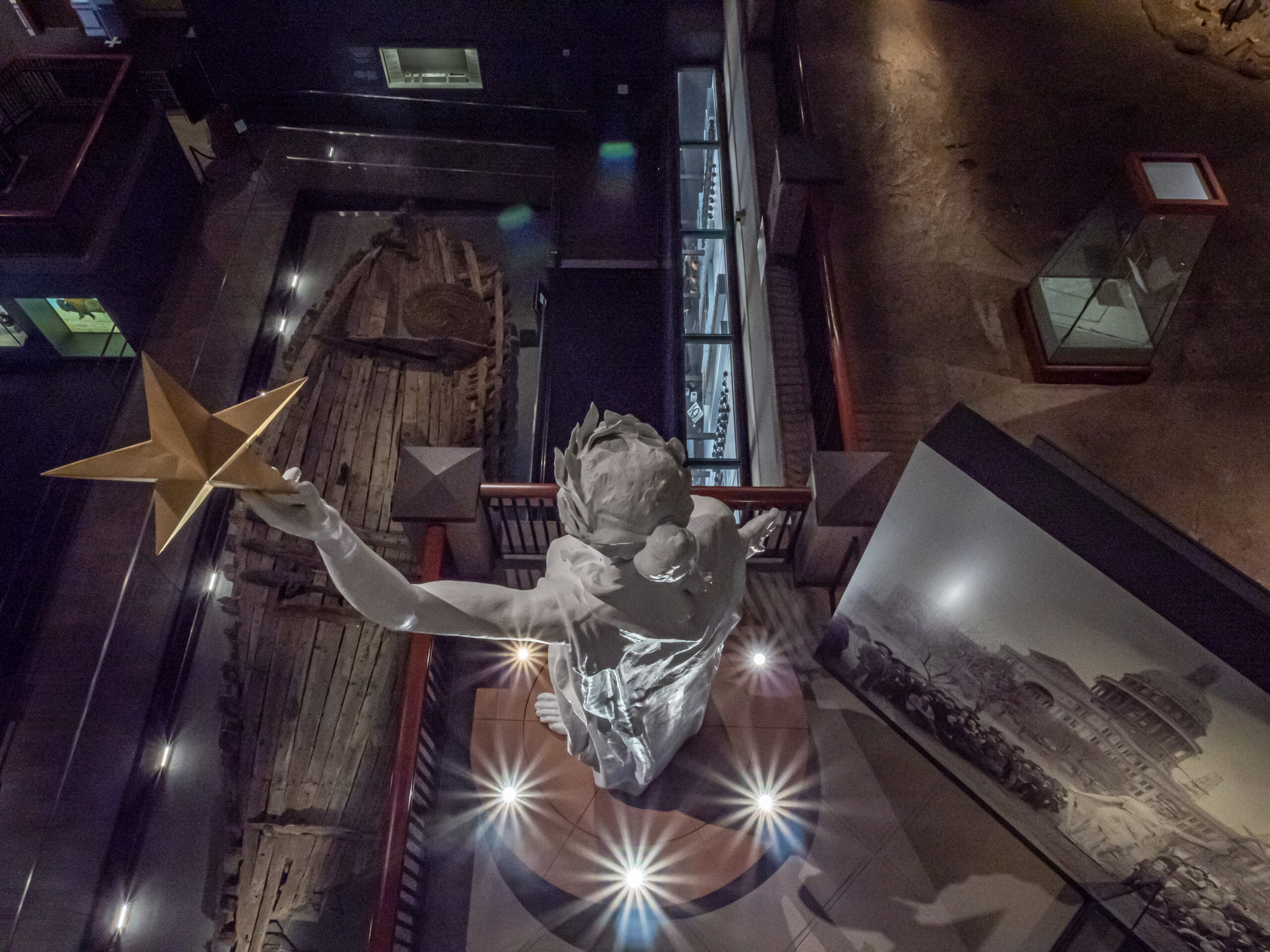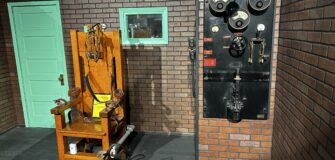
“Only death will end my love affair with Texas,” reflected former Lieutenant Governor Bob Bullock. As it turns out, though, that wasn’t quite true. In April 1999—two months before he would die—Bullock managed to attend the groundbreaking for a new museum, one that would not only be named for him, but would also showcase the history of the state he loved.
The Bullock Museum of Texas State History—all 175,000 square feet of it—reflects Bullock’s larger-than-life personality and his love of Texas. It features two theaters—a 320-seat IMAX and the multi-sensory “Texas Spirit Theater”—an impressive rotunda that doubles as exhibit space, and three themed floors including hundreds of artifacts highlighting millennia of history.
Visitors enter through the rotunda, where they see—and likely walk across—the mosaic “Born Around the Campfires of Our Past,” by Texas artist Robert Ritter. This colorful piece includes the state’s flora and fauna, while also depicting those who have shaped Texas history. These representative individuals—Buffalo Soldiers, Vaqueros, Conquistadores, Missionaries, American Indians—are sitting around a campfire, presumably telling stories of their people and the land.
Some of these stories are told on the first floor of the Museum, which highlights “The Land,” the sprawling, geographically diverse region that is now Texas. Visitors learn of the early nomadic peoples, the exploration of the territory, the cultivation of the soil, and the battles that took place in—and for control of—the region. The centerpiece of this floor, however, involves a sea-faring vessel, La Belle, a French ship that ran aground and was disabled in Matagorda Bay in 1685. The Spanish found the “broken ship” the next year, but after salvaging items from it, La Belle was abandoned, forgotten, and underwater—for more than 300 years.
It was rediscovered in 1995, and much of its skeletal structure and more than 1.5 million artifacts from the ship were recovered. Indeed, the storage capacity of the modest-sized ship was staggering; among the many items it carried were more than 600,000 beads, 1,500 brass rings, and 100,000-plus pounds of gunpowder. Some of these items are spectacular: a colander, which looks like it could have been lifted from a 20th-century kitchen; a helmet with fine etchings; and, perhaps most impressive, an exquisitely detailed crucifix.
Interestingly, the Bullock Museum is a non-collecting museum, which means that the artifacts on display are on loan from collectors, including other museums. Sam Houston Memorial Museum (SHMM), for example, has, according to former Director Mac Woodward, “loaned the Bullock Museum artifacts such as Sam Houston’s leopard (jaguar) vest, Santa Anna’s chamber pot, and other items of historical interest.” This type of arrangement benefits both museums. It offers new artifacts to the Bullock Museum for display, while providing exposure to the SHMM and its holdings.
Of course, this also means that artifacts leave the Bullock Museum periodically, to be replaced by items loaned from other sources. In the case of La Belle, however, the vessel has been a mainstay since its installation, and Museum staff note that their custodianship of their first-floor centerpiece is “very long-term.”
For many, the second floor, which tackles the state’s quest for “Identity,” is the most intriguing and familiar. It is here visitors will learn about Stephen F. Austin’s journey to Texas and the work that made him the “Father of Texas;” see Elisabet Ney’s “Sam Houston” statue; follow narratives of the Alamo and the Battle of San Jacinto; and explore the state’s tumultuous early days in the Union and unfortunate time in the Confederate States of America. Interpreters are occasionally on hand to provide information about the era or one of the Museum’s many artifacts.
The third floor of the Museum showcases collections that reflect the state as a land of “Opportunity.” The state’s oil industry is featured; ranching and farming are discussed; air and space exploration are highlighted; Texas’ first-class medical facilities are spotlighted; and Texas’ contribution to music are showcased. Images of and facts about notable Texans—from Farrah Fawcett to Michael DeBakey—are on display.
Looming large amidst these three floors is the omni-visible Goddess of Liberty. This artifact is the original statue that sat atop the Texas Capitol until 1985, when she was replaced by a younger, aluminum alloy replica. Following a brief tour of parts of Texas and some cosmetic surgery, this original Goddess was put on display in the Museum in 2001.
The Museum describes her as “formidable,” which is true, but it is also true that she was not chosen for her beauty. Rather, her features were purposefully exaggerated—protruding lips, a gherkin nose, and a brow that would embarrass a caveman—to provide shape to a face designed to be viewed from afar. These features are particularly emphatic when seen up close, which is the view from almost anywhere in the Museum. Standing at more than 15-feet tall, she continues to command Texans’ attention.
The Museum features entertainment options in the form of an IMAX theatre, which occasionally offers movies or documentaries that reflect the theme of Texas, special exhibitions, or other “educational” fare. Currently, for example, they are showing films on the Serengeti, the Arctic, and dinosaurs. For pure entertainment, they are also offering Ant-Man and the Wasp: Quantumania. In the smaller, multi-sensory “Texas Spirit Theatre,” visitors can view Shipwrecked to learn more about La Belle or The Star of Destiny, to brush up on key events in Texas history.
The Museum also has gallery space for rotating exhibitions. With 2023 being the 100th anniversary of the Texas State Park System, the Bullock is featuring artwork capturing the beauty, mystery, and diversity of the state’s many parks and historical sites. The 34 paintings on view reflect a sample of the 65 works commissioned by the Texas Parks and Wildlife Department for this centenary. The works, according to Museum staff, “prompt meaningful reflection on the natural beauty of public lands and their significance as places of solace, rejuvenation, recreation, and refuge.”
One of these paintings, undertaken by Lee Jamison, highlights a public site of great significance: the San Jacinto battlefield. The landscape was undertaken from a flattering angle, one that deemphasizes the region’s swampy terrain and minimizes the prominence of refineries and their attendant smoke plumes. What is depicted is a painting of variegated grasses and multihued plants, and a blue sky, composed in a horizontal landscape punctuated by a vertical monument to the State’s aspirational culture.
This quiet and beautiful scene depicting marsh grasses and woods, according to Jamison, somewhat disguises “the grim realities of the long-ago Battle,” which reflected, among other things, poor planning on Santa Anna’s part. But the “nature of the land contributed to the outcome of the battle,” continues Jamison, and therefore may “provide insight into our park system and the influence of the land on our state culture.”
The “Art of Texas State Parks” will remain on display through April 30.
Apart from the Museum’s name, Bob Bullock maintains a presence in the structure. A bronze statue of the long-serving state official stands on the second floor, gavel in hand, in front of a limestone wall engraved with the words, “God Bless Texas,” a reminder of the force and the sentiment behind the Museum.
Bullock’s statue faces eastward, toward newly redesigned exterior grounds. The Lone Star Plaza remains, along with its large, bronze star-shaped sculpture. But gone is a three-block portion of Congress Avenue; in its place is a pedestrian promenade that, with surrounding buildings, makes up the “Texas Mall.” This Mall will, according to its designers, serve as the “northern gateway to the Capitol,” where Bob Bullock once labored as Lieutenant Governor, and where, in 1995, he first discussed the idea of the state history museum that now bears his name.
Bullock Texas State History Museum
www.thestoryoftexas.com
1800 Congress Ave, Austin, TX 78701
(512) 936-8746

Postcards Magazine
936-293-1188
PO Box 690
Huntsville, TX 77342
